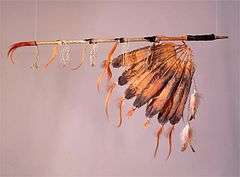The red road
The red road is a modern English-language concept of the right path of life, as inspired by some of the beliefs found in a variety of Native American spiritual teachings.[1] The term is used primarily in the Pan-Indian and New Age communities,[2][3][4] and rarely among traditional Indigenous people,[3][4] who have terms in their own languages for their spiritual ways.[5] Native Americans' spiritual teachings are diverse. While some peoples share common elements in their beliefs, the cultures are highly individualized. The ceremonies and many of the beliefs are unique to the people of these diverse bands, tribes and nations.[5]

Black Elk
In his book Black Elk Speaks, John G. Neihardt explored spiritual beliefs as he says they were told to him by Black Elk (1863–1950), an Oglala Lakota and Catholic.[6] Neihardt is non-Native. In the late 20th century, his work was criticized as diverging from, and misrepresenting, Lakota beliefs and ceremonies.[7][8]
Neihardt said that Black Elk believed he had an obligation to "help to bring my people back into the sacred hoop, that they might again walk the red road in a sacred manner pleasing to the powers of the universe that are one power."[9]
"Hear me, four quarters of the world--a relative I am! Give me the strength to walk the soft earth, a relative to all that is! Give me the eyes to see and the strength to understand, that I may be like you. With your power only can I face the winds.
Great Spirit, Great Spirit, my Grandfather, all over the earth the faces of living things are all alike. With tenderness have these come up out of the ground. Look upon these faces of children without number and with children in their arms, that they may face the wind and walk the good road to the day of quiet.
This is my prayer; hear me now!"- "Black Elk's Prayer for All Life"[10]
Treatment of addictions
In some modern addiction treatment programs, the idea of the Red Road may be part of the recovery process. Some of these programs are primarily for Native populations, but take a Pan-Indian or New Age approach, through "the Sweat lodge, the Red Road, and the Recovery Medicine Wheel."[11] Other "Red Road to Recovery" programs are not run by or for Native people, but are groups of predominantly non-Native, New Age adherents.
Mainstream usage
The phrase "The Red Road" has been picked up by many non-Native adherents of New Age and hippie lifestyles, based on their interpretation of Native American spirituality.[2] Critics have accused such followers of cultural appropriation and misrepresentation.[3][4][12][13]
See also
- Alcohol and Native Americans
- Blessing Way
- Cultural imperialism
- Curandero
- Declaration on the Rights of Indigenous Peoples
- Great Race (Native American legend)
- Indigenous decolonization
- Midewiwin
- Medicine wheel
- Music for The Native Americans, a 1994 album by Robbie Robertson and the Red Road Ensemble
- Native American Church
- Native American Spirituality Movements
- Neoshamanism
- Plastic Shaman
- Stereotypes of Native Americans
- Traditional knowledge
References
- Evan T. Pritchard, Native American Stories of the Sacred: Annotated & Explained, Sky Light Illuminations: 2005. Quote: "Black Elk, in The Sacred Pipe, speaks of the Red Road as the north-south cross of the Medicine Wheel, and the east-west cross as the black or blue road, the way we ..."
- McGaa, Ed, Rainbow Tribe: Ordinary People Journeying on the Red Road. HarperCollins, 2009.
- Deloria, Philip J., Playing Indian. New Haven: Yale University Press, 1998. ISBN 978-0-300-08067-4. Chapter Six: "Counterculture Indians and the New Age"
- Huhndorf, Shari Michelle, Going Native: Indians in the American Cultural Imagination. Cornell University Press, 2001. p.164
- Native American Stories of the Sacred: Annotated & Explained, 2005- Page xi "One unifying feature of Native American belief is the concept of the "Red Road", though each tribe and nation also has its own name for it. Black Elk speaks of the Red Road in the book The Sacred Pipe."
- Neihardt, John G. (1932, William Morrow & Company) Black Elk Speaks
- DeMallie, Raymond (Nebraska University Press, 1985). The Sixth Grandfather: Black Elk's Teachings Given to John G. Neihardt, ISBN 0803265646. Introduction and notes throughout the book.
- Carl Silvio Archived 2007-10-07 at the Wayback Machine, Internet Public Library, academic arguments on authorship, translation, and interpretation for prospective audiences have been written by Carl Silvio, among others. Note: This site has been superseded since 2010 by www.ipl2.org, a consortium of universities, accessed 19 June 2011
- Willis Goth Regier, Masterpieces of American Indian Literature. U of Nebraska Press, 2005, p. 580. ISBN 0-8032-8997-9.
- Walker, "A Social Ethical Analysis of BLACK ELK SPEAKS", Southern Methodist University.
- RD VICK, LM Smith, CIR Herrera - The healing circle: An alternative path to alcoholism recovery Counseling and Values, 1998 - Wiley Online Library "... Therefore, the incorporation of tribal spiritual teachings and practices into the recovery process can be crucial to its success. Three elements are central to the recovery process: the Sweat Lodge, the Red Road, and the Recovery Medicine Wheel."
- Aldred, Lisa, "Plastic Shamans and Astroturf Sun Dances: New Age Commercialization of Native American Spirituality" in: The American Indian Quarterly issn.24.3 (2000) pp.329-352. Lincoln: University of Nebraska Press.
- G. Hobson, "The Rise of the White Shaman as a New Version of Cultural Imperialism." in: Hobson, Gary, ed. The Remembered Earth. Albuquerque, NM: Red Earth Press; 1978: 100-108.
External links
- Sacred Sites of the United States
- Don Coyhis and White Bison, Inc., The Red Road to Wellbriety in the Native American Way, Colorado Springs, CO: Coyhis Publishing & Consulting, Inc., 2006 ISBN 0971990409